|
NUMBER 25 APRIL 1997 |
|||
|
Editor's Corner Council News British News Excavations at Birkside Fell, July and August 1996 The Flint Scatter The Birkside Fell Cairn European News Bog Bodies, Sacred Sites and Wetland Archaeology Conference, Denmark, 13-16 September 1996 WARP-speed in Denmark: A Review of Bog Bodies, Sacred Sites and Wetland Archaeology. September 13-16th, 1996, Silkeborg, Denmark. Hungarian Training Week for Aerial Archaeology The Sakçagözü Project: The Early Prehistory Of The North Levantine Rift Valley International News Excavations and Survey in the Rohri Hills (Sindh-Pakistan): 1996 Campaign Late (Upper) Palaeolithic Sites The Balochi Camp Conferences Books For Sale And Finally... Stuart Piggott: A Further Note
|
|||
|
LEADING
FRENCH PREHISTORIAN HONOURED
|
|||
|
Jean Clottes is the President of the ICOMOS committee
on rock art, Chairman of the Société Préhistorique de l'Ariège,
and General Inspector for Archaeology with the French Ministry of Culture
where he is Scientific Advisor for all matters relating to prehistoric
rock art. He is also Honorary President of our sister organisation,
the Société Préhistorique Français. Although his doctoral research
was on megalithic monuments, he is best known for his work on the decorated
Upper Palaeolithic caves of southern France and his prodigious publication
record. In recognition of these achievements, and in particular his
international efforts to promote the preservation of rock art sites,
he was admitted an Honorary Fellow of the Society of Antiquaries of
London on 7th November 1996. |
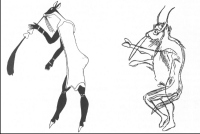 Shamans in Art: a therianthrope, half spirit animal and half human, depicted in South African rock art (left, after Lewis-Williams and Dowson). Note the Human hand but hoofed feet and nasal bleeding which results from self-induced trancing. Compare this with the well-known engraving of the Nsmall corcerer with musical bow from Trois-Frère in France (right, after Breuil). Note the human legs but hoofed hands: is it really a musical bow held to the jaw, or nasal bleeding? |
||
|
When A R Wilcox published his Rock Paintings of the Drakensburg
in 1960 he looked to European scholars, such is Breuil, for an interpretation
of the largely animal-based pictures of southern Africa. Now the direction
of inspiration is reversed and Jean Clottes has sought to introduce into
the interpretation of the French sites modern ideas of the belief systems
of southern Africa. In themselves, Lewis-Williams's ideas are a fine example
of eclectic research, combining the results of modern neuropsycholoy with
the same nineteenth century ethnographic records available to Wilcox and
others. In essence, he maintains that many scenes in Bushman rock art
depict the experiences of shamans who, through self-induced trance, seek
to harness the powers of the spirit world to effect change in the living
world. The animals carefully painted and engraved on rock surfaces are
the manifestations of spirits whose potency is sought by the shaman. Some
images which depict half human and half animals (therianthropes) represent
the shaman at the point of transcendence from the living to the spirit
world. The second element of his thesis is that because the same neurological system exists in all humans, wherever they live, they will share common experiences when subjected to altered states of consciousness, such as in trance. Hence, the therianthropes of South Africa may be similar to the "sorcerers" of Trois Frère, for example, in the geometric symbols seen in both areas the record of similar visions seen during the early stages of trance. The different animals represented in the two continents are merely a consequence of the different environments enjoyed by the shaman artists. In Les Chamanes de la Préhistorique, Clottes presents a well-balanced and up-to-date review of the European evidence and the development of ideas, which, until now, were rooted in the early anthropological studies of the indigenous hunter-gatherers of America and Austrailia. The overall intention of this collaborative effort is not to discredit earlier works but to broaden the debate on the motivation behind a most intriguing form of archaeological evidence using source material previously somewhat neglected in France. This is not the first time that shamanism has been considered as a possible belief system for the Upper Palaeolithic, but this is certainly the first time outside a specialist framework that such ideas have been presented so persuasively. In the same way that shamanism bridges different worlds (the living and the spiritual), so also does this book by uniting the previously isolated worlds of rock art research in Europe and southern Africa. Jean Clotte's desire to bring new ideas to bear on familiar territory bodes well for the future of Palaeolithic studies in France, not least because he is to lead the study of Chauvet, the latest "giant" in the repertoire of decorated French caves. This privilege was by no means a foregone conclusion: only after competing tenders had been scrutinised, in May 1996, was his team selected for the task. Although the study is unlikely to start before 1998, we wish him bonne chance with this exciting, if testing, project. We look forward with eager anticipation to the reconsideration of some of the structuralist ideas of parietal art, so tenaciously maintained by some scholars, which were developed without the benefits of the direct painting of the surprising, predator dominated painted scenes of the Chauvet Cave.
|
|||
|
|
|||
|
Well, here we are in 1997 and the Silver Jubilee issue of PAST. We have a truly international flavour to this issue, with reports on the WARP conference at Silkeborg, lots of European Archaeology and an article on archaeology in the Rohri Hills of Pakistan.
There is also a fascinating footnote to the obituary of Stuart Piggott from David Allen which gives what appears to be the earliest example of machining on site. Looking ahead, please remember that the AGM is on the 7th May at the Society of Antiquaries. Your papers for the AGM should be arriving very soon. This is also almost the end of my time as Editor of PAST - you will find out in the next issue who the new Editor will be. I would like to thank all the people who have contributed to PAST with articles, letters and photos - your contributions are very much appreciated.
|
|||
| Notes from the Secretary
Lady Clark has very kindly offered the Society her late husband's (Professor Sir Grahame Clark) complete set of Proceedings. The Society has some shelf space for its archive in the basement of the Society of Antiquaries, London, and in May it is hoped to transfer the set there.
|
|||
|
|
|||
|
Excavations
at Birkside Fell, July and August 1996
|
|||
|
In the late summer of 1995 fieldwork carried out as part of the Tyne-Solway Ancient and Historic Landscapes Research Programme led to the discovery of important Mesolithic and Bronze Age sites at approximately 380m AOD (NGR NY 934512) on Birkside Fell, in the North Pennines. Erosion of the thin peaty soils which mantle the fell have exposed an extensive scatter of stone tools and the partially denuded remains of a cairn.
|
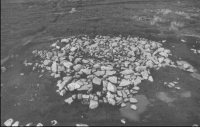 Illustration: Birkside Fell Cairn after initial clearance | ||
|
At the time of its initial discovery flints were found scattered across an area about l00m north-south and 20m east-west. The finds were wholly unexpected and a small surface collection was made. This produced no diagnostic items and did not delimit any particular concentration within the broader spread. In all 120 pieces of struck flint and two flakes, apparently of epidotized intermediate tuff (petrological Group VI), were collected from the surface.
|
|||
|
|
|||
|
The erosion at Birkside Fell had also partially exposed the upper levels of a roughly circular stony mound. This structure consists of several concentric rings of stone defining a central area filled with smaller stones, most of which lie roughly horizontal to the ground surface. The outer concentric ring of stones consists of substantial boulders and, in effect, forms a kerb. This kerb is most continuous on the southern side of the monument where the surviving arc suggests an original diameter of about four metres. The cairn was recorded in full at this level and its excavation will be resumed in 1997. However, present indications are that it may be classified as a variant of the ring-cairn class of monuments and dated to the earlier part of the Bronze Age.
|
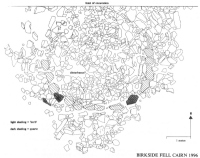 The Birkside Fell Cairn after initial clearance |
||
|
|
|||
|
Bog
Bodies, Sacred Sites and Wetland Archaeology Conference, Denmark, 13-16
September 1996
|
|||
|
Members of the Prehistoric Society and WARP attended a highly successful
and well organised conference in Silkeborg, Jutland. The conference
was organised by John and Bryony Coles and Mogens Schou Jorgensen. It
focused on various aspects of wetland archaeology and coincided with
a major international exhibition of bog bodies at Silkeborg Museum.
|
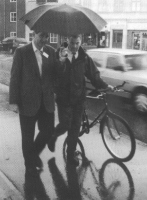 Weynard van der Sanden, Drents Museum, instigator and a major contributor to the Bog Body exhibition, wheels his bike through the Silkeborg rain, sharing the umbrella of Barry Raferty from Dublin, who also gave the opening address to the Conference (photo: Byrony Coles) |
||
|
Many of the other papers illustrated the great potential of wetland archaeology
and the varying ways in which it has been addressed in different countries.
The paper by Naama Goren Inbar reviewed a well preserved Middle Pleistocene
site in the Dead Sea rift. From the British perspective, the two Danish
contributions by Flemming Rieck and Anders Fischer were equally remarkable.
Anders Fischer gave an account of the reflooding of a small area of important
wetland at Amose which has resulted from the blocking of land drains.
Although this work only involves a limited part of an extensive wetland
area, it represents a substantial and expensive project which has been
promoted by archaeologists rather than nature conservationists. Flemming
Rieck's account of recent work on the remarkable but threatened ritual
boat deposits at Nydam was enlightening but also disturbing. The range
and quality of the artefacts from the recent excavation is stunning but
the degree of damage to these sensitive wet deposits which is resulting
from changes in vegetation and water level poses a major threat to this
site of international importance. A number of other papers addressed management issues and interesting variations emerged in the ways that different nations and agencies manage their wetland archaeology. The problem of large scale peat extraction and the destruction of wetland archaeology in Ireland were explored by Barry Raftery. Little evidence was produced at the conference to indicate that this scale of industrial destruction of wetland archaeological deposits is occurring elsewhere. Several papers presented accounts of survey and management initiatives in a number of countries and it is apparent that resources for wetland survey and management are far from being equally distributed. On a more detailed level, Richard Brunning's account of the provisional results to investigate the success of the management measures implemented at the Sweet Track, Somerset, England, is very reassuring to anyone wishing to manage wetland archaeological sites. The study indicates that the track is being adequately protected by the measures put into place in the early 1980s. Bryony Coles explored the significance and potential of the lost land of Dogger (the area between Britain and Jutland) and her paper raised the importance of a more detailed comprehension of changes in sea level since the Ice Age, a topic which was also evident in the discussions of estuarine archaeology. | |||
|
Aspects of community involvement in wetland work were evident in several of the papers including Dale Croe's interesting account of the joint Makah Tribal Nation/Washington State University project at the Hoko River site (USA). Some instructive contrasts emerged in discussion between the Hoko River project and native American involvement in the area of Canada which was discussed by Roy Carlson. Christine Finn described the way that bogs, bog finds and bog bodies have inspired writers, particularly poets. Her paper raised in my mind one topic which was not discussed in the formal sessions of the conference the ethical questions emerging from the public display of bog bodies. |
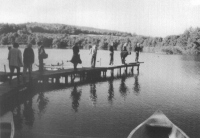 Excursion day - members of the society peer into the waters of a lake near Silkeborg, where sport divers have recently discovered a medieval fortified lake site (photo: Byrony Coles) |
||
|
The conference included a reception at Silkeborg Museum and viewing of the bog body exhibition. It ended with a field trip to wetland sites and other archaeological sites around Silkeborg, including a visit to the impressive prehistoric displays at Moesgard Museum and a memorable visit and wine reception at Bjeldskovdal Moss (the find spot of Tollund Man and Elling Woman). The reception was sponsored by the Prehistoric Society. This was followed by three days of optional excursions to the National Museum in Copenhagen, the Institute of Maritime Archaeology and the Viking Ship Museum in Roskilde and the Conservation Department and prehistoric wood store at Brede. All involved appeared equally impressed by the scale and organisation of Danish wetland archaeology and by the hospitality of our Danish hosts.
|
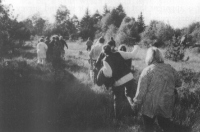 Tollund Fen: more bog bodies on the way? (photo: Byrony Coles) |
||
|
WARP-speed
in Denmark: A Review of Bog Bodies, Sacred Sites and Wetland Archaeology.
September 13-16th, 1996, Silkeborg, Denmark.
|
|||
| Silkeborg was this year's
venue for the joint Wetland Archaeological Research Project (WARP) and
Prehistoric Society conference - an appropriate location, being the home
of Tollund Man and so close to other important wetland discoveries. Over
60 participants from Europe, North America and Japan converged on the
hotel of Gammel Skovridergard in Silkeborg for two days of papers, poster
sessions and a series of post-conference excursions. A splendid reception was hosted by the Mayor of Silkeborg and the National Museum of Denmark to welcome the participants. Professor Barry Raferty's opening address on Friday evening discussed the emergence of bog archaeology in Ireland. His paper focused on the numerous trackways which have excavated in the Irish midland's since 1985. While in one sense Bord na Mona (the Irish Peat Board) has facilitated the discovery of many new sites, the conflict between archaeological interest and commercial exploitation of wetlands was clear. The issues of preservation versus destruction and sources of funding for wetland archaeology were to emerge as salient themes of the conference. Bryony Coles began the first full day of papers by considering the Lost Land of Dogger, speculating on the nature of past settlement on the now submerged land mass between Britain and the Continent. The next two papers in the session presented results of recent fieldwork in intertidal areas of Britain and Ireland. Martin Bell's work in the Severn Estuary served to remind us again of how much evidence we miss by looking at dry-land sites alone. The discovery of rectangular 'houses' at Goldcliff and Redwick contrasts with the more typical round houses known from Early Iron Age dry-land sites and may well represent specialised seasonal exploitation of the wetland environment. The importance of new intertidal discoveries was reinforced by Aidan O'Sullivan's report on the work of the Irish Wetlands Unit in the Shannon Estuary, where the muds of the Shannon have revealed finds ranging from a Mesolithic canoe to medieval fishtraps. The remainder of Saturday was devoted to bogs and bog bodies themselves. Christian Fischer, curator of the Silkeborg Museum, opened the session by putting into context the famous bog bodies from the Silkeborg area. He speculated on the intriguing connection between sacrificial deposits placed in bogs and the importance of peat for fire and bog iron (bogs being the only source of iron in Denmark). Both Turner and Bennike presented graphic evidence of the violent deaths of many of the bog bodies. A striking example of a violent death was seen in an adult man from a bog near Holmegård with a bone spear or arrowhead through his nasal opening and another in his chest. Bennike further noted how individuals recovered from bogs were, as she put it, "a strange group of people". Three of 27 skeletons from bogs exhibited evidence of trepanation (in all cases the patients survived the operation!) and three of violent death. Interestingly, two young males with trepanations also had crippled arms. The bog body group was also unusual in the high proportion of young people (37% from bogs compared with only 11% from dry land graves). The conclusion that young and disabled people were preferentially selected for sacrifice in bogs seems inescapable. The evidence of murder or ritual sacrifice for many of the bog bodies gives us a vivid insight into the final moments of these peoples lives. Indeed, the power of the bodies as a source of literary inspiration to writers and poets, notably Seamus Heaney, was discussed by Christine Finn. Yet, while the bog bodies personalise prehistory, they are isolated finds devoid of cultural associations. This point was particularly driven home by Rick Turner (the only archaeologist to actually find a bog body) in his entertaining paper on the discovery of the Lindow Moss finds. This presents interpretational challenges, especially given the difficulties in dating such remains, another theme of Turner's paper and also of his recent edited volume (Turner and Scaife 1995; see in particular Housley et al. 1995). Eva Koch continued the theme of bogs as repositories for offerings, not only of people, but also of pots and animals going back as early as the Neolithic. The importance of the bog as a site for ritual deposition appears to have continued into the Middle Ages and perhaps beyond. As noted by Wijnand van der Sanden for the Netherlands and northern Germany, simple ceramics found in bogs may have very well been offerings made by local peasants. This raised the question of how ritual deposition can be identified, as opposed to more mundane behaviour. On another scale entirely are the massive ritual deposits of Iron Age boats and weaponry as seen at Nydam and Illerup. Flemming Rieck reported on the ongoing excavations by the National Museum of Denmark at Nydam, with finds of weaponry, personal gear, horse tackle and clinker-built boats. It is thought that these lake sites contain the accoutrements of defeated warriors, although their bodies were absent. Stylistic elements suggest a number of influences in the warrior's gear; most spectacularly the finds at Illerup which include 150 Roman swords. The amazing preservation of many of the European bog bodies has led to speculation on the factors responsible. Heather Gill-Robinson advocated an experimental approach to address these concerns. Lamenting the unavailability of human cadavers, Heather made do with naturally deceased piglets. After apologising for the graphic nature of the slides Heather presented some results from her initial experiments, involving the differential preservation of piglets placed in and on bogs and comparative experiments of piglets in tap and spring water (?). Thankfully Danish bacon was not on the menu at the Museum reception! Saturday evening came the time to finally see the bodies in the flesh. This unique exhibition, opened in August by Nobel Prize-winning Irish poet Seamus Heaney, brought together 16 of the most famous examples from around Europe, as well as skeletal remains from bogs. The event was opened by Christian Fischer; who enlightened us on the nearly insurmountable problems attendant on mounting an exhibition of this nature, and on the instrumental role of Wijnand van der Sanden. P.V. Glob's (1969) well-known photographs hardly did justice to the emotive power of the contorted bodies laid before us. From the slit throat of Grauballe Man to the silent scream of Yde girl, the corpses confronted us with images of our own mortality. The sacrificial nature of many of these individuals was again driven home by the staked-out body of Queen Gunhilde (and by the disturbing image of the blindfolded Windeby girl). In contrast to the often lifelike appearance of the fleshed bodies, the skeletons on display were contorted, liquorice-twisted by their sojourn in the bogs. But the emphasis on death was mitigated by the glimpses of the people's lives afforded through details of their clothing and hairstyles. Look out for the revival of the Swabian knot, tricky in execution but very stylish! All the while, Tollund Man lay alone in his room, undisturbed by the revelry of the wine reception. The second day of papers began, after a revealing night of cultural and social interaction, with concurrent sessions on subsistence and survey/management. The importance of wetlands for a range of resources - as evidenced by the recovery of articulated fish skeletons in traps at the Russian site of Zamostje and the wealth of plant remains from the Jomon sites - was emphasised by several speakers in the subsistence session. Lisbeth Pedersen discussed the discovery of large Danish Neolithic fish traps and weirs. These facilities testify to a considerable investment of labour; raising questions about the extent of ownership and the development of social inequality. The need for large quantities of hazel rods implies coppicing and woodland management, offering prospects for integration with dry-land concerns. The survey and management session explored the potential of wetlands for palaeoenvironmental as well as archaeological information. Predictive modelling was discussed by Richard Hingley and Robert Middleton as a strategy to aid the management of wetlands in north-west England and Scotland. Richard Brunning reported on monitoring the condition of the Sweet Track and evaluating the effectiveness of in situ preservation. The theme of the final session was a summary of major wetland projects from around the world. Roy Carlson and Dale Croes presented papers on the Northwest Coast of North America where the participation of indigenous peoples was an issue. The recovery of waterlogged wood from an Acheulian site in the Dead Sea Rift excavated by Naama Goren-Inbar indicates the considerable chronological depth of wetland preservation issues. Ironically, the conditions responsible for organic preservation proved detrimental to the survival of basalt handaxes. Other papers emphasised the range of different approaches and in particular the extent of state funding available for wetland research in different countries. The high level of financial support for large projects in Japan and Switzerland was clear from the papers by Akira Matsui, Beat Arnold and Denis Ramseyer. A major concern was the conflict between modern commercial development of the land and the preservation of archaeological remains. Strategies for the protection of Danish prehistoric sites, including the state purchase of threatened land and land swaps, were discussed by Anders Fischer. On an optimistic note the possibilities of manipulating EU funding and influencing policy affecting land-use were raised, and the necessity for interdisciplinary cooperation in the achievement of this goal was stressed. While we three dry-land archaeologists were suitably impressed by the scope of the conference and the richness of wetlands, we also see a need for greater dialogue between dry-land and wetland archaeologists and consideration of wider concerns. The focus on trackways presents an excellent example of this, a case of not seeing the forest for the trees. There was little discussion (the exceptions serving only to point out the general absence of debate) of the context of the trackways within prehistoric society. Who built and maintained them? Where did they lead and who used them? Tilley (1994) has recently advocated an approach to the landscape considering pathways, and how such movement influences people's perceptions and can be manipulated. The preservation of so many track-ways would seem to offer an excellent opportunity to explore some of these ideas in more detail. Hopefully upcoming WARP conferences - to be held in Japan next year and in Ireland the following year - will address such issues. On Monday we were treated to an excursion to a number of scenic spots in the vicinity of Silkeborg, Mosegård museum - the home of Graubelle man, and later to Bjeldskovdal Moss, the findspot of Tollund Man and Elling Woman. |
|||
| At Mosegård museum we were welcomed by Søren Andersen who told us about recent findings at the submerged Mesolithic site of Tybrind Vig over a smørrebrød. The museum director also described to us the conservation programme for Graubelle Man. We ended the conference by visiting the place where Tollund man was exposed after 2,200 years in the peat. Fittingly we toasted his memory with Nydam wine (5 Kr. from every bottle goes to fund the excavations - we must have contributed quite a bit). And now he lies perfected in our memories.
|
 Christian Fischer, curator of the Silkeborg Museum and one of the conference organisers, speaks to WARP at Bjeldskoval Moss, where Tollund Man and Elling Woman were found (photo Rick Schulting) |
||
|
References Glob, P V, 1969 The bog people: Iron Age man preserved, Faber & Faber, London Housley, R, Walker, A J, Otlet, R L, and Hedges, R E M, 1995 Radiocarbon dating of tbe Lindow III bog body, in R C Turner arid R G Scaife (eds), Bog bodies: new discoveries and New Perspectives: 39-46, British Museum Press, London Tilley, C, 1994 A phenomenology of landscape, Berg, Oxford Turner, R C and Scaife, R C (eds), Bog bodies: new discoveries arid new perspectives, British Museum Press, London
| |||
|
Hungarian
Training Week for Aerial Archaeology
|
|||
|
The aerial archaeology training week, held at Siofork, near Lake Balaton, Hungary, in June was a huge success and will be seen as a landmark in the development of aerial archaeology in Europe.
|
|||
|
The
Sakçagözü Project: The Early Prehistory Of The North Levantine Rift
Valley
|
|||
|
The Near East lies at the "bridgehead" between Africa, Europe and Asia, however our knowledge of the Palaeolithic period is still very limited. Much of the information relating to the colonisation and behaviour of early hominid and later hunter-gatherer populations stems from field studies undertaken in the central and southern Levant. The Neolithic is more widely known, having benefitted from recent salvage excavations in the upper Euphrates and Tigris systems, and work in central Anatolia, but there are still significant gaps in regional coverage. One neglected, but potentially significant area, is the north Levantine corridor lying between the Euphrates and Mediterranean.
|
|||
|
|
|||
|
Excavations
and Survey in the Rohri Hills (Sindh-Pakistan): 1996 campaign
|
|||
| In 1992 a project of archaeological cooperation was signed by the Department of Archaeology of the University of Khairpur (PK) and the Department of Historical-Archaeological and Oriental Sciences of the University of Venice (I) in order to survey and record the archaeological area of the Rohri Hills, in the Khaiptir and Sukkur districts, the most important flint quarrying area of the Harappan civilisation. |
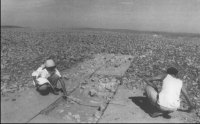 Excavation in progress at the Late Palaeolithic workshop ZPS2 (photo P Biaga) | ||
|
According to the data so far available, the Harappan quarrying activity took place over an area of some 15 square kilometres. The quarries and their related workshops are often grouped together; so that in some cases they almost border the edges of the terraces facing the Indus Valley. They are distributed in two main distinct areas: the first, to the east of the Shrine of Shadee Shaheed, rather close to the tomb of Ziarat Pir Shaban; the second, south of the shrine itself as far as the Tomb of Adam Sultan. A shallow depression, from which originate many streams leading to the same wadi, separates the two groups of structures. Four Harappan sites have been excavated so far. The preliminary analysis of the data obtained during the first three years of exploration led to the understanding of some aspects of the flint quarrying activities carried out during the Harappan period. The research has pointed out the importance of the Hills for the exploitation of the flint sources and for the trade of the flint blade products to the urban sites of the Indus Valley and related territories. The impressive amount of traces of quarrying and associated chipping workshops demonstrates the existence of a specialised craft and a mass-production of tools for anonymous consumers, reflecting the social complexity of the Harappan civilisation. Unfortunately some dating problems are still open to question, such as the duration of the exploitation of the flint quarries on the Rhohi Hills and the chronological sequence of the various workshops and of the different chipping techniques. Only one AMS date is actually available from a piece of charcoal found between the stone rubble inside the quarry pit 862, dated to 3870±70 BP (GrA-3235), which indicates that the quarry was exploited during the Mature Harappan Civilisation.
|
|||
|
Late (Upper) Palaeolithic sites
|
|||
|
The discovery of the first Late Palaeolithic site (1288) was made on 12 January 1994, during a survey on the hills extending east-south-east of the Shrine of Shadee Shaheed. The surveys of the last two years have demonstrated that the Late Palaeolithic workshops border the western edge of the terrace for some 5 km.
One of these workshops, called ZPS2, was excavated over an area of 18 square metres in February 1996. The excavation yielded some 500 artefacts, cores and hammerstones which are most probably attributed to an initial stage of the Late Palaeolithic in the Indian sub-continent given the presence of short, pyramidal bladelet cores, similar in shape to circular, carenated end scrapers. Samples for palaeopedological and phytolith analyses have been collected from this site as well as from some of the previously mentioned Harappan sites.
|
|||
|
|
|||
|
During March of the same year, a recently abandoned Balochi seasonal camp has been accurately mapped and sampled for botanical and geological analyses.
The camp, which lies in the interior of the hills had been abandoned six months before and consisted of seven huts located close to a water well. The 1996 season of fieldwork has been sponsored by the Prehistoric Society, The National Geographic Foundation, Technoquartz Ltd, and Medical Systems Ltd. The team was composed of the writer, M M Kazi, E Concina, F Negrino, E Starnini, A Concina, C H Burdi, M Madella and C Ottomano.
|
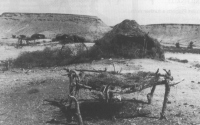 Recently abandoned Balochi camp (photo P Biaga) | ||
|
|
|||
|
Supply and Circulation of Metals in Bronze Age Europe
|
|||
|
|
|||
|
|
|||
|
Stuart
Piggott: a further note
|
|||
|
A small but significant footnote can be added to the appreciation of Stuart Piggott's life and time (Fire Among The Ruins, PAST 24). Over sixty years ago, in January 1936 to be precise, he undertook the excavation of the Holdenhurst long barrow near (Christchurch, Dorset, on behalf of Alexander Keiller and the Morven Institute of Archaeological Research. It was rescue work, as plans to build houses on the site were well advanced, and Piggott had a grant of £30, the services of three workmen, and a number of volunteers. Through local contacts, notably J B Calkin, Piggott established good relations with the site owners, the Cooper-Deans, and the contractors, Messrs Loader. Indeed Mr Loader 'took a personal interest in the excavations' and eventually provided not only human labour, but mechanical labour too.
Given the size of the monument, Piggott deduced that 'a complete excavation of the barrow was impossible in the time and with the funds at our disposal' and decided that 'the plan of the barrow as determined by the quarry ditches which it must have had originally, and by any internal structure that there might be, was the first desideratum'. When a hand dug trench showed that the ditch was deeply buried by the spread mound it was decided, 'not without some considerable initial hesitation', to use one of Loader's mechanical excavators, already on site, to dig trial trenches. So effective was this novel method, which could be managed 'with accuracy and surprising delicateness' that a number of cuttings were made with the machine 'in a remarkably short space of time'. | |||
|
As Stuart Piggott himself was to point out, this was the first known deliberate
use of a machine to assist archaeological excavation (PPS, 3, 3)
and was ground-breaking in more ways than one. To our lasting good fortune
this defining moment was captured by box camera, and the excavator is
seen poised at the end of one of the nine trenches it cut. Incidentally,
when putting together the new archaeology displays at the Red House Museum,
Christchurch, in 1990, I did enquire to see if there were any further
prints than the handful we held of the Holdenhurst dig, and the more or
less contemporary Latch Farm work undertaken by Mrs Piggott. The answer
was in the negative, and the recollection was of 'rather poor-weather;
mid-winter affairs' .... but for archaeological excavation, a defining
moment none the less.
|
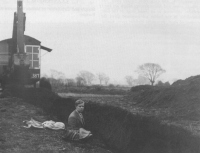 Stuart Piggott at Holdenhurst Long Barrow | ||
 |
The Prehistoric Society Home Page |

